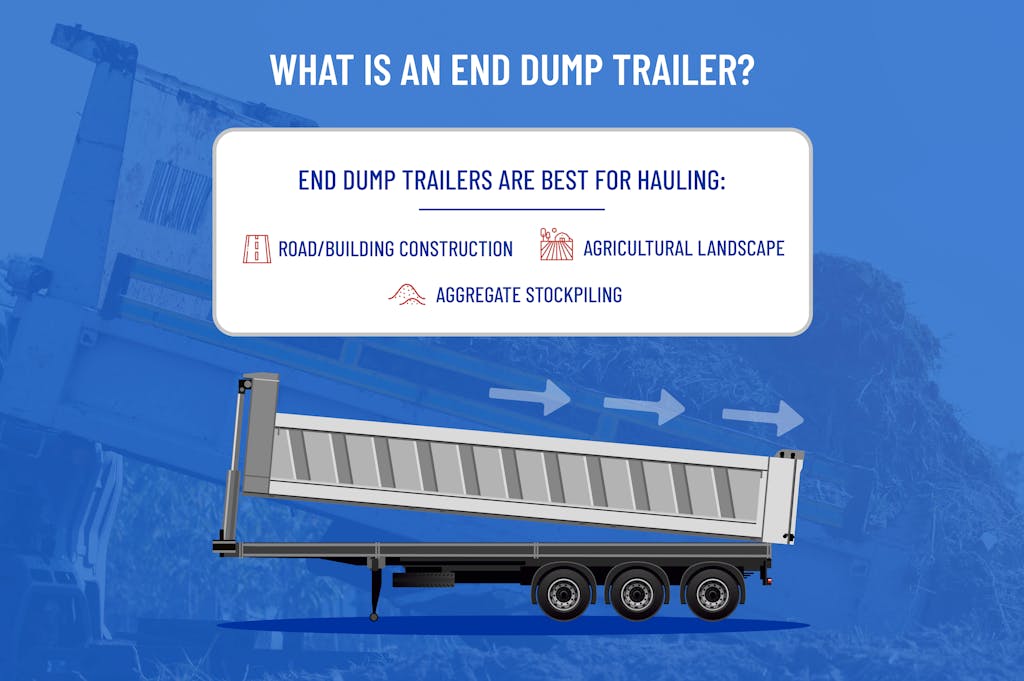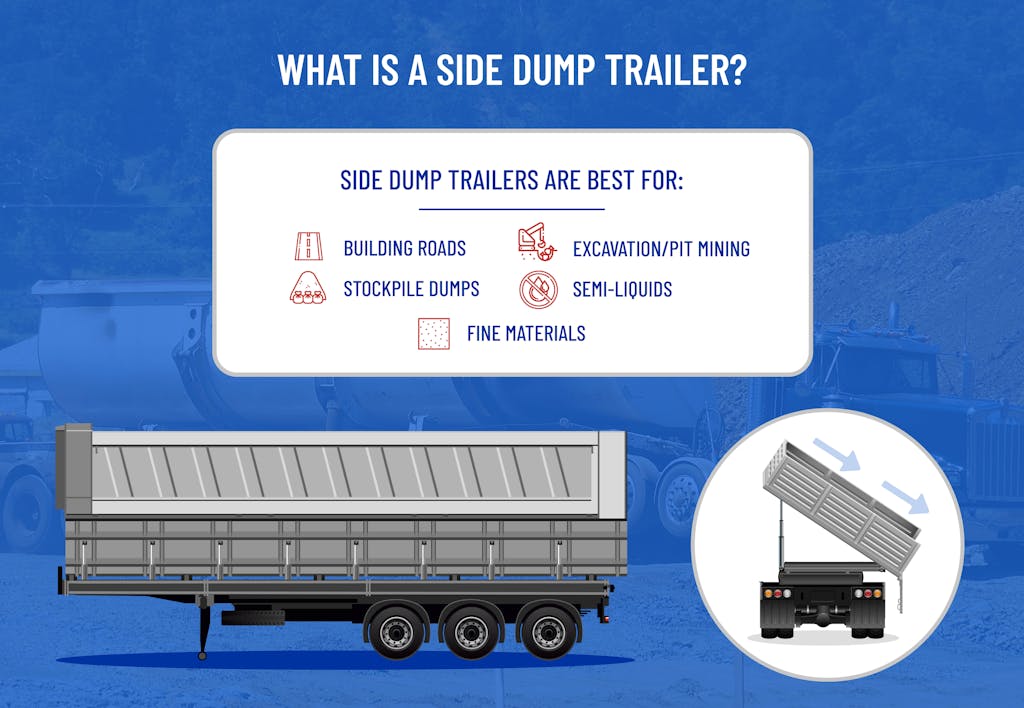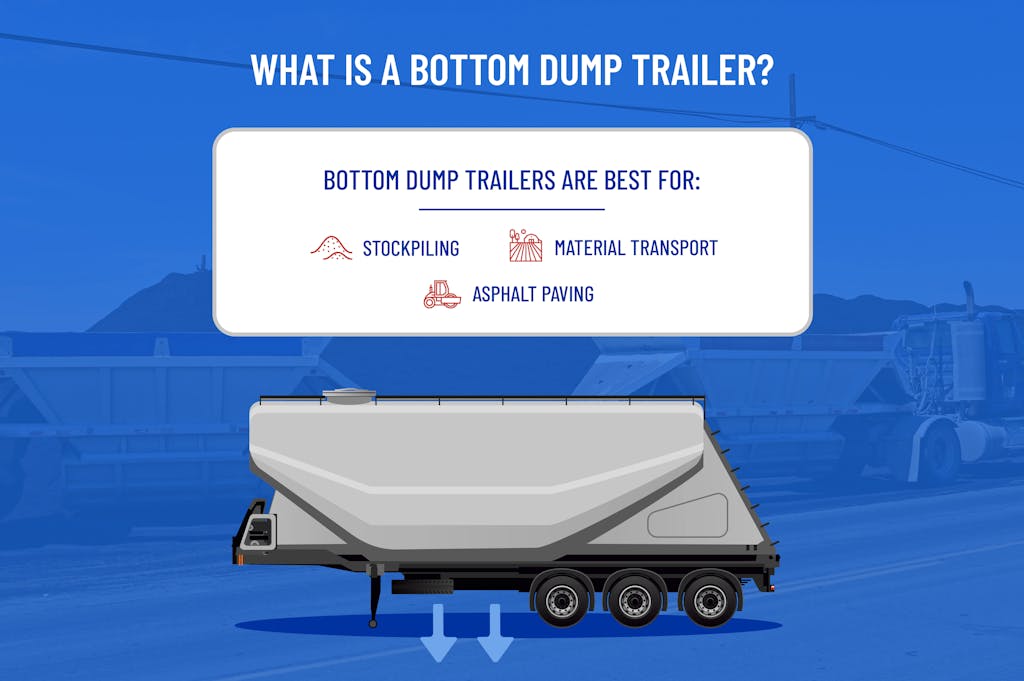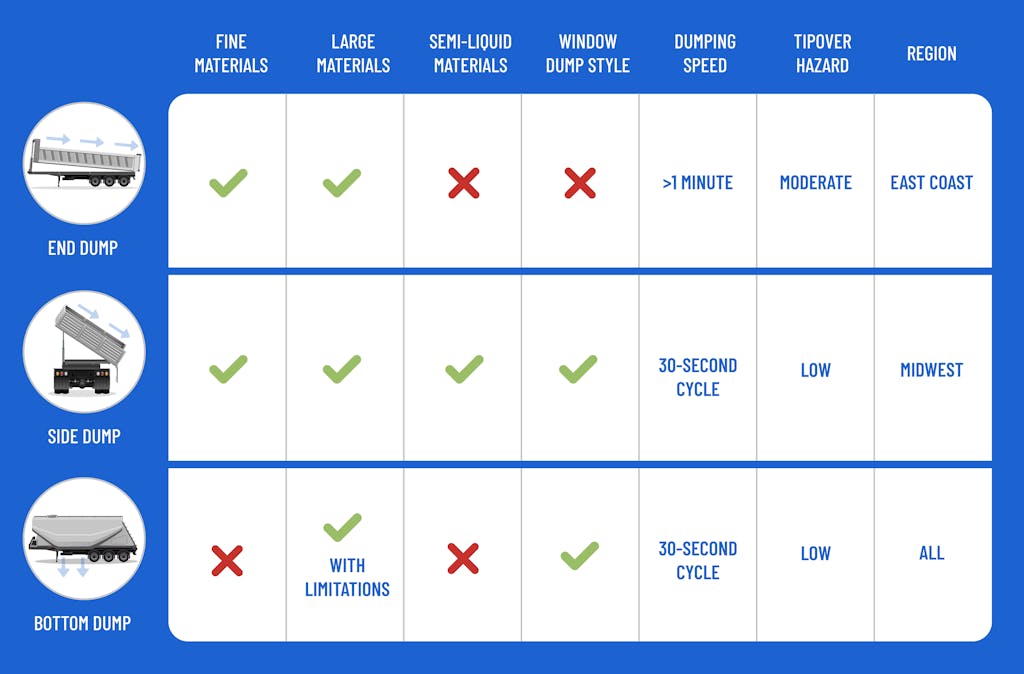End Dump vs. Side Dump vs. Bottom Dump Trailers
August 17th, 2020
When determining the best dump trailer for your business—side dump, belly dump, or end dump—you’ll need to understand the differences and consider all of your options before choosing a dump trailer. If you’ve been limited in your operations due to the type of trailer you’re using, it may be time to invest in a new or used dump trailer for sale with the type of configurations that will give you the versatility to get the job done right.
Whether you’re looking for a bottom, side, or end dump trailer to support your hauling needs, consider these key factors before making your next purchase, including the differences between trailers, top features, what they haul, and the benefits/limitations of each.
Dump Trailers: What Are the Differences?
Dump trailers come in three main types: end dump trailer, bottom (or belly) dump trailer, and side dump trailer. While weight and axle spacing regulations may often determine which type of dump trailer you need, knowing what each dump trailer is best suited to haul, and their advantages and disadvantages, can help you make a smart investment when deciding on a trailer.
What Is an End Dump Trailer?

An end dump trailer unloads by lifting its dump box into the air and dumping from the rear. Often made of aluminum, end dumps typically have higher sides than belly and side dumps, which give them greater capacity to handle larger loads and rough materials for greater payloads.
End dump trailers are best for hauling:
- Road/building construction
- Aggregate stockpiling (requires a loader)
- Agricultural landscape
Advantages of End Dump Trailers
End dumps trailers have a heavy-sided design that allow you to carry larger loads than bottom or side trailers. You can handle a variety of difficult materials—from demolition debris to concrete—with rapid unloading. End dumps are ideal for operators on the East Coast, and are an ideal choice for working in confined spaces.
Disadvantages of End Dumps
End dump trailers tend to have more issues with stability. They are typically harder to maneuver and require a highly skilled operator. End dumps can become increasingly unstable if the unloading position is not level or if materials shift around during transport. They are not recommended for hauling semi-liquids since the rear gate is hard to seal from leakage.
What Is a Side Dump Trailer?

A side dump trailer has hydraulic rams that unload its cargo by tilting the right or left side of the trailer, providing greater stability. Side dumps do not require the air ride suspension to be deflated before dumping, which allows for rapid unloading.
Side dump trailers are best for:
- Building roads
- Stockpile dumps (requires a loader)
- Excavation/pit mining
- Semi-liquids
- Fine materials
Advantages of Side Dump Trailers
Generally safer for offloading, side dump trailers offer the most stability with few limitations. Easy and safe to operate, side dumps can dump on soft or uneven ground safely without needing to back up or find level ground for unloading.
Disadvantages of Side Dumps
Although you can run side dumps in multiple-trailer configurations, they generally have a smaller cubic capacity and limited maneuverability for unloading in confined areas. Side dumps are generally found in the Midwest and West Coast, where a dump site must be properly configured specifically for side dumps.
What Is a Bottom Dump Trailer?

The bottom dump trailer, sometimes referred to as a belly dump trailer, has a clamshell dump gate on the trailer that allows you to dump materials straight from the bottom of the box. This enables windrowing, which releases materials in a long line instead of a dumping pile.
Bottom dump trailers are best for hauling:
- Stockpile (requires a loader)
- Material transport
- Asphalt paving
Advantages of Bottom Dump Trailers
Bottom dumps are a highly versatile and efficient way to haul materials. Belly dump trailers are designed to minimize weight and maximize payload, offering quick turnaround times. Bottom dumps are highly stable and won’t roll over since they don’t need to be raised for dumping.
Disadvantages of Bottom Dumps
There are some restrictions for using a bottom dump since the axles of the trailer must have clearance above the windrow. Belly dumps should not be used for hauling larger materials that can hang up under the suspension. They are also not suitable for hauling liquids or fine materials that can leak out of the bottom gate. Side dump usage is restricted by the region where you are operating.
Side Dump vs. End Dump vs. Belly Dump Trailers: Which to Choose?

Choosing your dump trailer will be based mostly upon the kind of work you’re planning to do. Depending on your projects, one type of dump trailer might be suitable for more than one application. Use these guidelines to help you decide:
When to Use an End Dump Trailer?
End dumps are ideal if you regularly haul hauling difficult and heavy materials such as large demolition debris. Since they are heavy-sided, you’ll need these for carrying heavy and tougher loads. Since end dumps can become unstable when dumping in uneven areas, make sure you can utilize this trailer for these types of applications. These trailers are ideal for job sites on the East Coast.
When to Use a Side Dump Trailer?
With a side dump trailer, you can safely unload a wide variety of materials with a faster dump cycle for increased efficiency. Side dumps are highly versatile and used for a variety of applications, including site prep, construction, and excavation. For hauling fine materials and liquids, side dumps trailers have a water-tight tub that won’t leak like end dump or belly trailers. Side dump trailers are best for job sites in the Midwest, and are only viable if the jobsite is specifically configured for side dumps.
When to Use a Bottom Dump Trailer?
Bottom dumps trailers are ideal for laying asphalt, and material transport, with the added versatility of a chassis mount. Bottom dumps are helpful when you need to control the gate opening and have the ability to regulate material flow.
Average Sizes of Dump Trailers
Considering the right type and size of dump trailer should be based on your overall operations. Here is a general breakdown of the differences in size between frameless dump trailers, framed dump trailers, and dump bodies:
- Dump trailers generally range from 26 feet to 40 feet in length; however, you may also find shorter dump bodies, which can vary from 17 to 18 feet.
- Frameless dumps, while lighter and allowing for heavier loads, are longer than framed dumps, which means they require more room for dumping. Frameless dump trailers range from 36 to 40 feet in length.
- Framed dumps are shorter and are more efficient for jobs that require you to navigate tight spaces. Framed dump trailers range from 26 to 34 feet in length.
- Dump bodies are much shorter, making them a viable option when the dump site is very small or requires maneuvering through tighter spaces. Dump bodies will likely range from 17-18 feet in length.
Contact Our Trailer Experts
Hale Trailer Brake & Wheel has the widest variety of trailers for your dumping needs. Whether you’re looking for new dump trailers for sale, used dump trailers for sale, or dump trailers for rent, browse our extensive selections to find the perfect trailer for your needs.
Our trailer sales locations offer a large inventory of new and used dump trailers with helpful representatives to assist. Call for questions or details about trailers and locations at 800-232-6535. We look forward to helping you find the right trailer for your business.
All the information on this website – https://www.haletrailer.com – is published in good faith and for general information purposes only. Hale Trailer Brake and Wheel does not make any warranties about the completeness, reliability and accuracy of this information. Any action you take upon the information you find on this website, is strictly at your own risk. Hale Trailer Brake and Wheel will not be liable for any losses and/or damages in connection with the use of our website.
